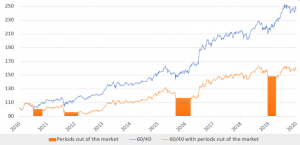An investment strategy that consistently sells a stock before it peaks and buys after the market reaches its lowest point is the Holy Grail for investors. The idea of timing the market appeals to our inner competitive streak, but there can be huge financial consequences if an investor gets that timing even slightly wrong.
Can you time the markets? The answer, in short, is no. If market timing was a viable investment strategy, everyone would be playing the markets on a regular basis, doubling their savings in a weekend before getting back to their daily lives. The reality is nothing like this – market timing is a near-impossible long term investment strategy that requires an incredible amount of not only knowledge, but time.
We recently examined the consequences of missing out on the periods of sharp recovery that almost always follow significant downturns in the markets.
The potential cost of getting it wrong
To assess the impact of withdrawing from the markets at the wrong time (or waiting too long to enter them), we examined the growth of two identical hypothetical portfolios (see the chart above). One portfolio (from a particularly poorly timed investor) was pulled out of the markets during the four major dips over the last 10 years and only reinvested once markets had recovered, while the other stayed the course and waited for the seas to calm.

As shown in the chart, missing out on recoveries can be very costly for long term investors. In the example, missing the bounce that followed the falls during the period led to a portfolio that was around 35% lower at the end, when compared to leaving it invested. Withdrawing investments meant, ultimately, missing out on around 60% of the portfolio’s growth.
Of course, an investor that attempts to time the market is unlikely to do as poorly as someone who sells at the bottom and buys at the top, but the opposite is also true. Timing the market is incredibly difficult and mistakes are inevitable. Our study simply highlights how costly those mistakes can be, whether they occur once or repeatedly.
Fools gold
Academics have shown that most active retail and institutional traders lose money in the long run because adopting a market timing strategy is very similar to gambling in a casino. The chance of being right is around 50%, but that 50% is eroded by trading costs, particularly when this is multiplied.
Some individuals manage to time the market well, but there are some big questions investors should ask themselves before trying to time the market:
- Do I have access to people who can time the market?
- Do I really think I can time the markets consistently given my skill set?
- Can I cope with the stress of market timing?
- Do I have the time needed for this activity?
Long-term macroeconomic trends, diversification and robust risk management help investors achieve sustainable long-term returns without targeting market timing. There are three key pillars that should underpin any investment strategy:
- Understanding of the long-term expected returns across asset classes – academic research makes it easier to predict 5-10 years returns than it does for returns over a few months.
- Ensuring that you have diversification in your portfolio to optimise market relationships and achieve better risk-adjusted returns, potentially through a buy and hold strategy.
- Ensuring that you preserve capital in difficult market conditions to ensure you have balanced returns.
Photo by Mathew Schwartz on Unsplash





